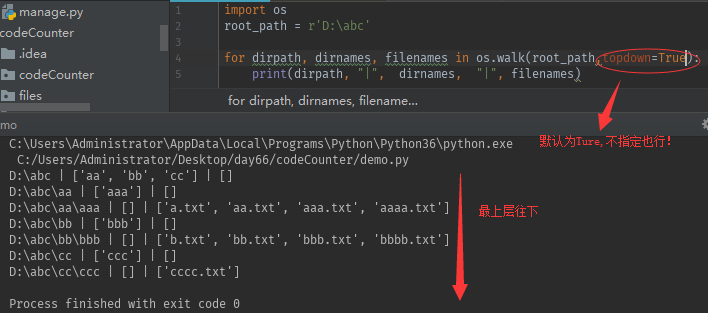python3-os模块中的os.walk(目录树生成器)
#先看源码
def walk(top, topdown=True, onerror=None, followlinks=False):
"""Directory tree generator. For each directory in the directory tree rooted at top (including top
itself, but excluding '.' and '..'), yields a 3-tuple dirpath, dirnames, filenames dirpath is a string, the path to the directory. dirnames is a list of
the names of the subdirectories in dirpath (excluding '.' and '..').
filenames is a list of the names of the non-directory files in dirpath.
Note that the names in the lists are just names, with no path components.
To get a full path (which begins with top) to a file or directory in
dirpath, do os.path.join(dirpath, name). If optional arg 'topdown' is true or not specified, the triple for a
directory is generated before the triples for any of its subdirectories
(directories are generated top down). If topdown is false, the triple
for a directory is generated after the triples for all of its
subdirectories (directories are generated bottom up). When topdown is true, the caller can modify the dirnames list in-place
(e.g., via del or slice assignment), and walk will only recurse into the
subdirectories whose names remain in dirnames; this can be used to prune the
search, or to impose a specific order of visiting. Modifying dirnames when
topdown is false is ineffective, since the directories in dirnames have
already been generated by the time dirnames itself is generated. No matter
the value of topdown, the list of subdirectories is retrieved before the
tuples for the directory and its subdirectories are generated. By default errors from the os.scandir() call are ignored. If
optional arg 'onerror' is specified, it should be a function; it
will be called with one argument, an OSError instance. It can
report the error to continue with the walk, or raise the exception
to abort the walk. Note that the filename is available as the
filename attribute of the exception object. By default, os.walk does not follow symbolic links to subdirectories on
systems that support them. In order to get this functionality, set the
optional argument 'followlinks' to true. Caution: if you pass a relative pathname for top, don't change the
current working directory between resumptions of walk. walk never
changes the current directory, and assumes that the client doesn't
either.
原文注释大概这么些意思:
这是一个目录树的生成器。对于位于顶部的目录树中的每个目录产生一个3元元组。(dirpath,dirnames,filenames)
第一个为起始路径,第二个为起始路径下的所有文件夹的名字,第三个是起始路径下的所有非目录文件。
dirpath 是一个string,代表目录的路径,
dirnames 是一个list,包含了dirpath下所有子目录的名字。
filenames 是一个list,包含了非目录文件的名字。
注意:这些目录和文件名字不包含路径信息,如果需要得到全路径,需要使用os.path.join(dirpath, name).,通过for循环自动完成递归枚举

如果可选的参数 'topdown'为真或未指定,则(目录是自上而下生成的)。

如果topdown为false,则子目录(目录自下而上地生成)。

当topdown为true时,调用者可以就地修改dirnames列表,(例如,通过del或slice赋值),并且walk只会递归到
子目录,其名称保留在dirname中;这可以用来修剪搜索,或强制执行特定的访问命令。
修改目录名的时候topdown为false是无效的,因为在dirname中有目录已经生成的时间dirname本身是生成的。
不管topdown的值,子目录列表在生成目录及其子目录的元组。
参数onerror的默认值是"None",表示忽略文件遍历时产生的错误.如果不为空,则提供一个自定义函数提示错误信息后继续遍历或抛出异常中止遍历
总结:
os.walk(top[, topdown=True[, onerror=None[, followlinks=False]]])
top -- 根目录下的每一个文件夹(包含它自己), 产生3-元组 (dirpath, dirnames, filenames)【文件夹路径, 文件夹名字, 文件名】。
topdown --可选,为True或者没有指定, 一个目录的的3-元组将比它的任何子文件夹的3-元组先产生 (目录自上而下)。如果topdown为 False, 一个目录的3-元组将比它的任何子文件夹的3-元组后产生 (目录自下而上)。
onerror -- 可选,是一个函数; 它调用时有一个参数, 一个OSError实例。报告这错误后,继续walk,或者抛出exception终止walk。
followlinks -- 设置为 true,则通过软链接访问目录。
python3-os模块中的os.walk(目录树生成器)的更多相关文章
- python的os模块中的os.walk()函数
os.walk('path')函数对于每个目录返回一个三元组,(dirpath, dirnames, filenames), 第一个是路径,第二个是路径下面的目录,第三个是路径下面的文件 如果加参数t ...
- python基础:os模块中关于文件/目录常用的函数使用方法
Python是跨平台的语言,也即是说同样的源代码在不同的操作系统不需要修改就可以同样实现 因此Python的作者就倒腾了OS模块这么一个玩意儿出来,有了OS模块,我们不需要关心什么操作系统下使用什么模 ...
- os模块中关于文件/目录常用的函数使用方法
os模块中关于文件/目录常用的函数使用方法 函数名 使用方法 getcwd() 返回当前工作目录 chdir(path) 改变工作目录 listdir(path='.') 列举指定目录中的文件名('. ...
- os、os.path模块中关于文件、目录常用的函数使用方法
os模块中关于文件/目录常用的函数使用方法 函数名 使用方法 getcwd() 返回当前工作目录 chdir(path) 改变工作目录 listdir(path='.') 列举 ...
- python编程os、os.path 模块中关于文件、目录常用的函数使用方法
os模块中关于文件/目录常用的函数使用方法 函数名 使用方法 getcwd() 返回当前工作目录 chdir(path) 改变工作目录 listdir(path='.') 列举指定目录中的文件名( ...
- python—— 文件的打开模式和文件对象方法 & os、os.path 模块中关于文件、目录常用的函数使用方法
引用自“鱼c工作室” 文件的打开模式和文件对象方法 : https://fishc.com.cn/forum.php?mod=viewthread&tid=45279&ext ...
- 有关文件夹与文件的查找,删除等功能 在 os 模块中实现
最近在写的程序频繁地与文件操作打交道,这块比较弱,还好在百度上找到一篇不错的文章,这是原文传送门,我对原文稍做了些改动. 有关文件夹与文件的查找,删除等功能 在 os 模块中实现.使用时需先导入这个模 ...
- OS模块中获取当前文件的绝对路径的相关方法
os.path.realpath(__file__) 作用:获取当前执行py脚本的绝对路径(在当前工作目录下的绝对路径) __file__ : 表示当前文件的本身,一般值是当前文件的相对路径 例如: ...
- Python OS模块中的fork方法实现多进程
import os '''使用OS模块中的fork方式实现多进程''' '''fork方法返回两次,分别在父进程和子进程中返回,子进程中永远返回0,父进程返回的是子进程的is''' if __name ...
随机推荐
- Codeforces Round #348 (VK Cup 2016 Round 2, Div. 2 Edition) A
A. Little Artem and Presents time limit per test 2 seconds memory limit per test 256 megabytes input ...
- POJ1797:Heavy Transportation(改造Dijkstra)
Heavy Transportation Time Limit: 3000MS Memory Limit: 30000K Total Submissions: 52728 Accepted: ...
- bzoj 4624 农场种植 fft
4624: 农场种植 Time Limit: 50 Sec Memory Limit: 512 MBSubmit: 48 Solved: 31[Submit][Status][Discuss] D ...
- centos关闭ipv6
1.使用lsmod查看ipv6的模块是否被加载. lsmod | grep ipv6 [root@dmhadoop011 ~]# lsmod | grep ipv6 ipv6 ...
- Nginx support TCP Load balance
1. Install nginx package 2. edit nginx configuration file [root@ip- nginx]# more nginx.conf user ngi ...
- CSS3学习笔记之径向展开菜单
效果截图: HTML代码: <div class="menu-wrap"> <nav> <a href="" class=&quo ...
- mpvue基本使用
## 什么是mpvue ## - 美团开发使用vue语法开发小程序的前端框架 - 适用于vue语法开发 - 会调用部分小程序API ## 创建mpvue项目 ## 1. 必须安装node.js 2. ...
- .NET之特性和属性(转)
1. 引言 attribute是.NET框架引入的有一技术亮点,因此我们有必要花点时间走进一个发现attribute登堂入室的入口.因为.NET Framework中使用了大量的定制特性来完成代码约定 ...
- Spring - IoC(9): @Resoure & @Autowired
@Resource 和 @Autowired 都是用来装配依赖的,它们之间有些异同. @Resoure @Resource 是 JSR-250 规范的注解. @Resource 可以标注在字段.方法上 ...
- php中的split函数
字符串分割函数:split函数 <?php $email='microsoft@exam!ple.com'; $domain = split('\.|@|!',$email);//split分割 ...
